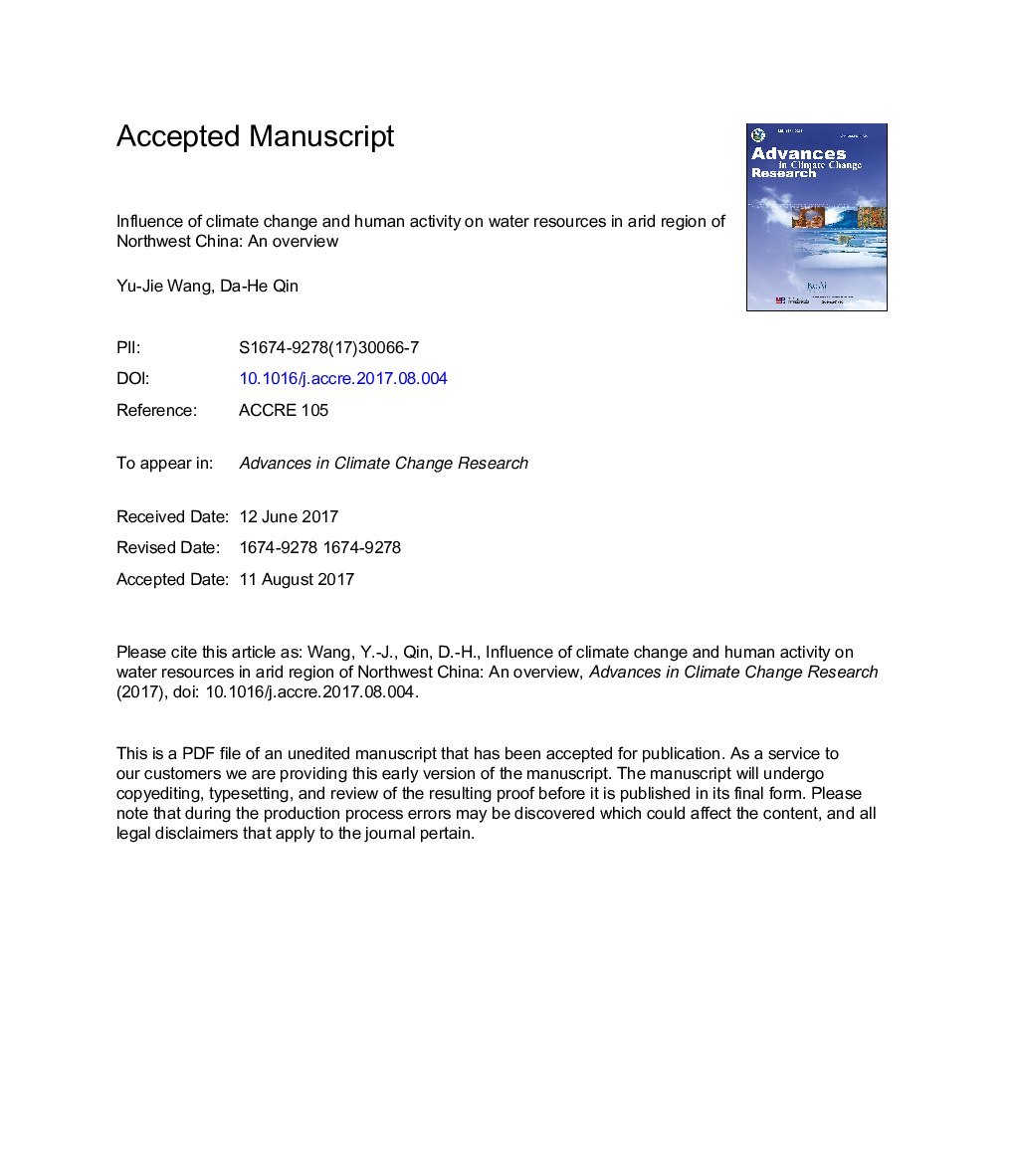| کد مقاله | کد نشریه | سال انتشار | مقاله انگلیسی | نسخه تمام متن |
|---|---|---|---|---|
| 8906199 | 1634089 | 2017 | 22 صفحه PDF | دانلود رایگان |
عنوان انگلیسی مقاله ISI
Influence of climate change and human activity on water resources in arid region of Northwest China: An overview
ترجمه فارسی عنوان
تأثیر تغییرات اقلیمی و فعالیت های انسانی در منابع آب در منطقه خلیج شمال غربی چین: یک نظرسنجی
دانلود مقاله + سفارش ترجمه
دانلود مقاله ISI انگلیسی
رایگان برای ایرانیان
کلمات کلیدی
منطقه خشک شمال غربی چین، تغییر آب و هوا، منابع آب، فعالیت انسانی، استراتژی اقتباس،
ترجمه چکیده
این مطالعه آخرین پیشرفت های تحقیقاتی در مورد تغییرات آب و هوایی و منابع آب در منطقه خلیج شمال غربی چین را بررسی می کند، علت تغییرات منابع آب در منطقه را از منظر تغییرات اقلیمی و فعالیت های انسانی بررسی می کند و خلاصه تغییرات احتمالی در منابع آب و استراتژی های انطباق مرتبط. این تحقیق نشان می دهد که آب و هوا در منطقه از سال 1961 گرم و مرطوب تر است و گرم ترین آنها در فصل زمستان است و بیشترین میزان بارش در تابستان از سال 1961 است. مناطقی که بیشترین میزان گرم شدن را دارند عبارتند از: حوضه قیدیم، دره رودخانه یلی و تاچنگ . به طور فزاینده، روند افزایشی بارش به طور چشمگیری از جنوب شرق به شمال غرب افزایش می یابد و شمال شین جیج بیشترین افزایش را تجربه می کند. مطالعات نشان می دهد که در رودخانه رودخانه شیانگ کاهش می یابد، زیرا رواناب عمدتا بر اساس بارش است که روند کاهش را نشان می دهد. اما افزایش در رودخانه های غربی از قبیل رودخانه طارم و رود شول و نیز رودخانه هایهه به علت انقباض سریع یخبندان و بارش برف و همچنین افزایش بارش در ناحیه کوه دیده می شود. در عین حال فعالیت های غیرمنصفانه انسان نیز موجب کاهش رواناب در وسط و پایین تر رودخانه هائه، رودخانه شیانگ و رودخانه کیدو شد. در نهایت توصیه هایی برای مطالعات آینده پیشنهاد شده است که شامل ویژگی های تغییرات در حوادث شدید آب و هوا و تأثیر آنها بر منابع آب، پیش بینی های آب و هوایی آینده و تغییرات منابع آب، استنباط تغییرات اقلیمی، انتخاب استراتژی های انطباق مربوط به تغییرات اقلیمی و فعالیت های اقتصادی اجتماعی و استفاده از روش های علمی برای تعیین مقدار منابع آب به صورت کمی.
موضوعات مرتبط
مهندسی و علوم پایه
علوم زمین و سیارات
علم هواشناسی
چکیده انگلیسی
This study reviews the latest progress in research on climate change and water resources in the arid region of Northwest China, analyzes the cause of water resource changes within the region from the perspective of climate change and human activities, and summarizes future likely changes in water resources and associated adaptation strategies. The research shows that the climate in the region has experienced warming and wetting with the most significant warming in winter and the highest increase in summer precipitation since 1961. Areas with the most significant warming trends include the Qaidam Basin, the Yili River Valley, and Tacheng. Spatially, the increasing trend in precipitation becomes increasingly significant from the southeast to the northwest, and northern Xinjiang experienced the highest increase. Studies have shown a decrease in headwater of Shiyang River because runoff is mainly based on precipitation which shows a decrease trend. But an increase in western rivers was observed such as Tarim River and Shule River as well as Heihe River due to rapid glacier shrinkage and snowmelt as well as precipitation increase in mountain area. Meanwhile unreasonable human activities resulted in decrease of runoff in the middle and lower reaches of Haihe River, Shiyang River and Kaidu River. Finally, recommendations for future studies are suggested that include characteristics of changes in extreme weather events and their impacts on water resources, projections of future climate and water resource changes, climate change attribution, the selection of adaptation strategies relating to climate change and social economic activities, and use of scientific methods to quantitatively determine water resource allocation.
ناشر
Database: Elsevier - ScienceDirect (ساینس دایرکت)
Journal: Advances in Climate Change Research - Volume 8, Issue 4, December 2017, Pages 268-278
Journal: Advances in Climate Change Research - Volume 8, Issue 4, December 2017, Pages 268-278
نویسندگان
Yu-Jie Wang, Da-He Qin,
